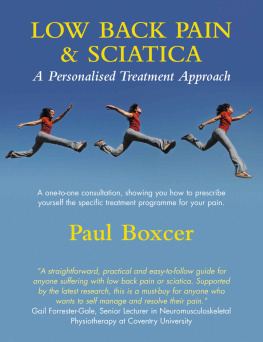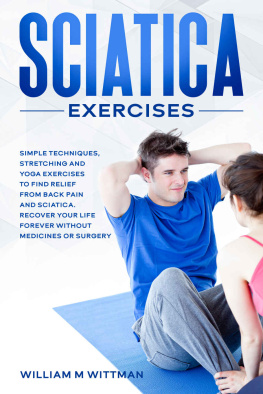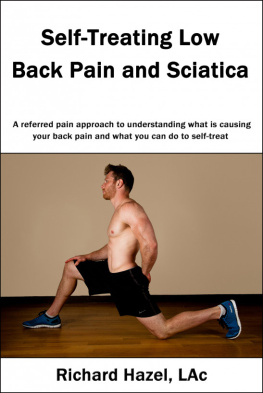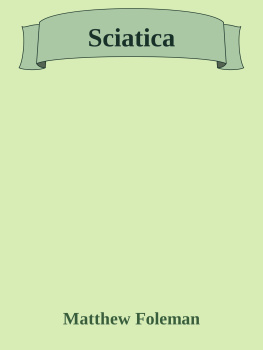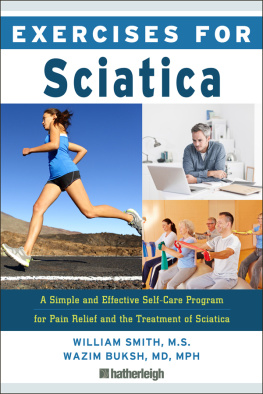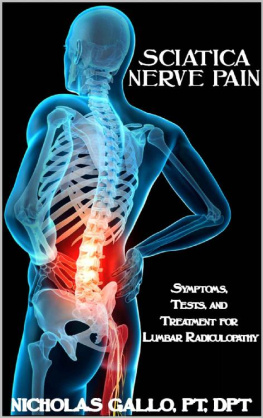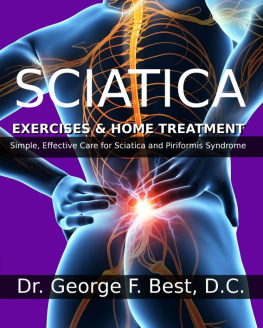LOW BACK PAIN & SCIATICA iii
LOW BACK PAIN&SCIATICA
A PERSONALISED TREATMENTAPPROACH
PAUL BOXCER


Spinal Health Publishing
iii
Copyright Paul Boxcer 2010First published in 2010 by Spinal Health Publishing331 Rainham Road, Rainham, Essex, RM13 7TBIllustrations Paul Bryn Davies
website: www.spinal-health-care.com
The right of Paul Boxcer to be identified as the author of the work has been assertedherein in accordance with the Copyright, Designs and Patents Act 1988.
All rights reserved.This book is sold subject to the condition that it shall not, by way oftrade or otherwise, be lent, resold, hired out or otherwise circulated without the
publishers prior consent in any form of binding or cover other than that in which it ispublished and without a similar condition including this condition being imposed onthe subsequent purchaser.
The information within this book is designed to provide helpful advice and informationfor those suffering with low back pain and/or sciatica.This book is not meant to be
used, nor should it be used, as a substitute for any professional medical advice you havereceived or may receive in the future. Any such advice should always take precedentover that which is written within this book.
The author is not responsible for any specific health needs which may require
professional medical attention nor is he liable for any injury, damages, losses or negativeconsequences resulting from following the advice and information within this book.The author wishes to make it clear that no advice or exercises taken from this bookshould increase any levels of pain the reader is suffering or worsen any signs and
symptoms the reader has. It is imperative that if this is the case, or the readers conditiondoes not improve, they seek professional medical advice.
British Library Cataloguing in Publication DataA catalogue record for this book is available from the British Library.ISBN 978-0-9562931-0-7
Typeset by Amolibros, Milverton, SomersetThis book production has been managed by AmolibrosPrinted and bound by
About the Author
Firstly, a little information about myself. My name is Paul Boxcer and afterleaving school at the age of sixteen I spent four and a half years workingfor a bank in the City of London. I then decided to up sticks and spendsome time travelling the world. After two years of travelling around Israel,Egypt, Europe, Australia and China, I decided it was time to settle downand get some kind of career behind me. I had two goals I wanted to achievewith this new career:
1) I wanted to help people.
2) I wanted to enjoy it.
Admittedly, there was no eureka moment as such but I was led into furthereducation (back to college to get some A Levels which I hadnt hung aroundto take the first time!) in order to pursue my new career. Fortunately, allwent well and I progressed to the University of East London to completemy degree in Physiotherapy.
After attaining a BSc (Hons) degree in Physiotherapy, I worked as aphysiotherapist within the NHS. Several years working around the UK weresoon followed by another attack of the travel bug and I decided to spendthe next two years working in Christchurch, New Zealand. During thistime, I was fortunate enough to work in one of the leading sports clinicsin the country. However, after two years in New Zealand the urge to comehome was too strong and since then I have been working back in Blighty.
During my time working as a physiotherapist, it has always intriguedme as to why some people suffering with pain get better and others do
v
noteven though their diagnoses and subsequent treatments may be thesame.This is particularly evident with individuals who suffer from low backpain and sciatica. It has been my own self-analysis of this that has culminatedin me writing this book.
Contents
Introduction1
The Principles of this Book13Here I explain the general structure of my book as well asany terminology I use throughout. Some phrases within thisbook are ones I tend to use from day to day and are morelikely to be specific to me as opposed to standard medicalterms.
Step One:
Red Flags21The first and most important step to take with regard toresolving your pain is to make sure it is musculo-skeletal innature, i.e. being caused by problems with muscles, joints &soft tissue. There are also other causes of low back pain andsciatica, and this chapter will highlight any specific signs andsymptoms that may indicate you are suffering from one ofthem. If you do have any of these signs and symptoms, thechances are there is nothing to worry about. However, it isalways best to err on the side of caution and seek professionalmedical advice.
Learning Zone:
Your Lower Back and Sciatic Nerve27 This is where I explain the functional anatomy of your lowerback and sciatic nerve. I go into detail, but not too much, to
vii
provide you with a good understanding of what the lowerback looks like, as well as explanations of the bones, joints,ligaments and muscles of which it consists. I also give adescription of the sciatic nerve, from where it begins and towhere it travels.
Learning Zone:
Why You are Feeling Pain51Any incorrect postures or movements, along with muscleimbalance, can lead to low back pain and/or sciatica. Duringthis chapter I explain why this is so and also describe the twotypes of pain you are likely to be suffering from, i.e. AcuteInflammatory Pain and Mechanical Pain.
Learning Zone:
Your Own Body is the Greatest Healer65Your body has an innate desire to heal itself. If you provide itwith the correct conditions it will heal itself and resolveyour pain.This chapter helps you understand why.
Step Two:
How to STOP Acutely Inflamed Pain71If you are suffering with an acute inflammatory attack of pain,the pain will be constant and unremitting. This type of paincan result in almost intolerable surges of pain with whatappears to be the simplest of movements. It will also feel as ifyou can do nothing at all to settle the pain downbut youcan! This chapter provides you with the information andadvice you need to ease this pain as quickly as possible. Apartfrom the great feeling of relief you will encounter, it willalso enable you to move on to exercises that will completelyresolve your pain.
viii
1) Side Lying with pillows79
2) Prone Lying with pillows80
3) Prone Lying80
4) Crook Lying80
5) Lying with your feet supported on a chair80
Step Three:
How to Optimise Your Bodys Healing Potential85It is important you harness as much of your bodys innatedesire to heal itself as is possible, if you are to resolve yourpain. In this chapter, not only do I show you how best todetect and eliminate the things that are interfering with yourbodys healing process, I also teach you how to detect andencourage the things that will facilitate that same healingprocess.This optimisation of your bodys healing potential willspeed up your recovery towards becoming free of pain.
Step Four:
How to Diagnose Your Pain99The crucial factor in resolving your pain is finding the correctdiagnosis. This section of the book explains the functionaldiagnoses I use and how you can provide yourself with thecorrect diagnosis for your low back pain and/or sciatica.Thereis a reason for me putting this diagnostic stage a little later inthe book. This is because prior to this, the primary goal isdirected towards acutely inflamed pain, where pretty muchanything and everything hurts. The main aim at that stage issimply to settle things down. As soon as the acute stage haspassed, however, you will then need to diagnose your problemand become more specific with regard to the exercises youneed to perform.This chapter addresses those issues.
Next page 
